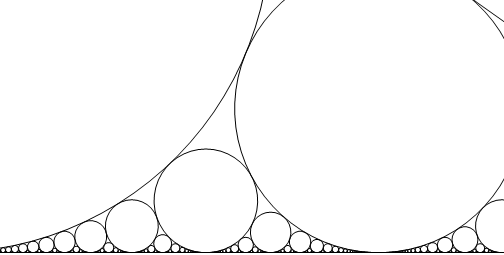This is another question about visualization of Ford circles, the previous one being Confusion with practically implementing rational approximationsConfusion with practically implementing rational approximations. Here is an output of zooming into Ford circles at $\frac1{\sqrt2}$
Empirically I found that the pattern repeats periodically and arranged the number of frames so that one gets impression of a continuous infinite zoom (however if one looks very attentively there is a slight jump where the animation restarts).
What I want to know is whether the pattern indeed repeats rigorously for quadratic irrationalities, and whether for other irrational numbers the pattern occasionally becomes "almost" the same (clearly if the number is rational then the picture eventually starts degenerating into the horizontal line).
Since I do not actually know how exactly to formulate it, let me ask the question in form that practically occurred to me: for a real $x$ denote by $P_r(c)$ the picture of Ford circles in the rectangle $(x-c,x+c)\times(0,c)$ with resolution $r$. That is, features of size less than $rc$ cannot be observed; in particular, only the Ford circles of radius $>rc$ are visible, and moreover a circle cannot be distinguished from another one if they are both contained in an annulus of width $<rc$.
For which $x$ do there for any resolution $r$ exist two different $c$ and $c'$ such that the pictures $P_r(c)$ and $P_r(c')$ cannot be distinguished? (Well, they must be "sufficiently different" - say, there is still another $c<c''<c'$ such that $P_r(c'')$ can be distinguished from both.)
And the question about this question - what is (if any) a rigorous mathematical statement behind it?
(Later - decided to add the zoom for the golden ratio, here the jump is almost impossible to notice
Circles closest to the center alternate between left and right, ratios of their sizes must be something like consecutive Fibonacci numbers...


